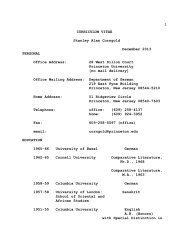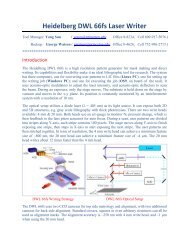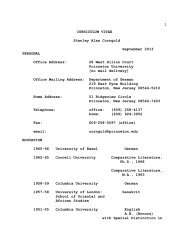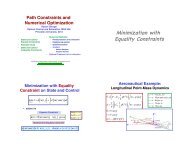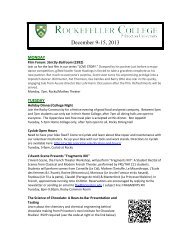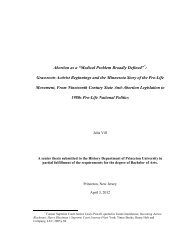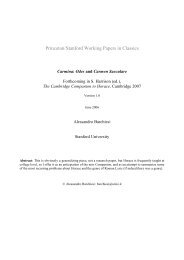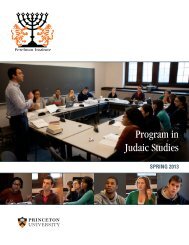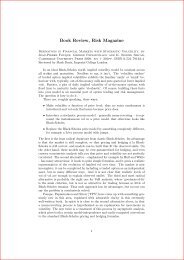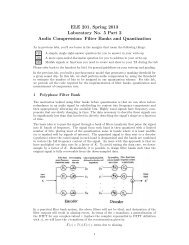Parametric and Nonparametric Linkage Analysis - Princeton University
Parametric and Nonparametric Linkage Analysis - Princeton University
Parametric and Nonparametric Linkage Analysis - Princeton University
You also want an ePaper? Increase the reach of your titles
YUMPU automatically turns print PDFs into web optimized ePapers that Google loves.
Kruglyak et al.: <strong>Parametric</strong> <strong>and</strong> <strong>Nonparametric</strong> <strong>Linkage</strong> <strong>Analysis</strong><br />
Such pedigrees are easier to collect for diseases characterized<br />
by late onset, low penetrance, <strong>and</strong> diagnostic<br />
uncertainty. They are also more likely to reflect the genetic<br />
etiology of the disease in the general population<br />
<strong>and</strong> are less likely to show intrafamilial genetic heterogeneity.<br />
The methods described here have all been incorporated<br />
into a new interactive computer package, GENE-<br />
HUNTER. The computer program is written in C <strong>and</strong><br />
is freely available from the authors, by anonymous ftp<br />
(at ftp-genome.wi.mit.edu, in the directory distribution/<br />
software/genehunter) or from our World Wide Web site<br />
(http: / / www-genome.wi.mit.edu / ftp/distribution /<br />
software/genehunter). We hope that GENEHUNTER<br />
will ease the task of efficiently analyzing pedigree data<br />
from genetic studies of complex traits.<br />
Acknowledgments<br />
L.K. would like to thank David Haussler for useful discussions<br />
<strong>and</strong> the Aspen Center for Physics for its hospitality during<br />
the 1995 workshop on biological sequences. We thank<br />
Richard Straub, Kenneth Kendler, <strong>and</strong> colleagues for sharing<br />
data from ISHDSF; Massimo P<strong>and</strong>olfo <strong>and</strong> colleagues for sharing<br />
their IGE data; <strong>and</strong> Melanie Mahtani, Elizabeth Widen,<br />
Mark McCarthy, Leif Groop, <strong>and</strong> other members of the Botnia<br />
diabetes project for helpful discussions <strong>and</strong> for sharing unpublished<br />
data. This work was supported in part by National<br />
Center for Human Genome Research grants HGO0017 (to<br />
L.K.) <strong>and</strong> HG00098 (to E.S.L.).<br />
Appendix A<br />
Computing the Single-Locus Inheritance Distribution<br />
at Codominant Loci<br />
We describe an algorithm for computing Pmarker, the inheritance<br />
distribution at a codominant marker locus,<br />
conditional only on the data for that locus. We begin<br />
by noting that it is sufficient to calculate P(Omarker v),<br />
the probability of observing the marker data for each<br />
inheritance vector v. One can then apply Bayes's theorem,<br />
together with the fact that all inheritance vectors<br />
are equally likely a priori, to calculate the probability<br />
distribution over inheritance vectors.<br />
Let X = {x1 ,x2, .. . ,X2f} be symbols corresponding to<br />
the 2f founder alleles at the marker locus, which are<br />
assumed to be distinct by descent. An inheritance vector<br />
v specifies the precise founder alleles inherited by each<br />
individual in the pedigree; let xi1(v) <strong>and</strong> xi2(v) denote the<br />
alleles carried by the ith individual. Let A = {a1, . .. ,ak}<br />
denote the observable allelic states; note that distinct<br />
founder alleles may have the same state. Let ai1 <strong>and</strong> ai2<br />
be the two observed alleles carried by the ith individual.<br />
An assignment of the founder alleles is a mapping<br />
function, f: X -- A. For any inheritance vector v, an<br />
1361<br />
assignment f is said to be v-compatible with the observed<br />
marker data if {f[x,1(v)],f[xi2(v)]) = ja,1 ,aiJ2 for all individuals<br />
who have been genotyped. (In other words, the<br />
assignment of founder alleles specified by f <strong>and</strong> the transmission<br />
specified by v are compatible with the observed<br />
genotype data.) Let p(ai) denote the population frequency<br />
of alleles having state ai. The probability of the<br />
assignment f is 17i p[f(xi)], which is the chance that the<br />
founder alleles will happen to have the states specified<br />
in the assignment.<br />
For a given inheritance vector v, the quantity<br />
P(oFmarker v) is equal to the sum of the probabilities of<br />
all v-compatible assignments. It thus suffices to find all<br />
v-compatible assignments. This can be done through a<br />
simple graph-theoretic process. Given v, define a graph<br />
G(v) whose vertices are the founder alleles<br />
{x1 ,x2, ... ,X2f} <strong>and</strong> whose edges are ei =[Xil(V),Xi2(V)b<br />
where i runs over all genotyped individuals. (Pairs of<br />
vertices in G(v) can be connected by multiple edges.)<br />
Label edge ei with the corresponding genotype fai1 ,ai2.<br />
The v-compatible assignments are those such that the<br />
label on each edge is consistent with the assignment of<br />
the two vertices of that edge. Choose an arbitrary starting<br />
vertex y. If y has no edges, then the corresponding<br />
founder allele does not appear in any genotyped individual,<br />
<strong>and</strong> it may be assigned to any ai. If y has edges, then<br />
its assignment necessarily must lie in the intersection of<br />
the labels on all edges from y; there are thus, at most,<br />
two choices for y. Given the assignment of y, the assignment<br />
of each neighboring vertex z is uniquely determined<br />
(since the pair of assignments of y <strong>and</strong> z must<br />
correspond to the label on any edge connecting them).<br />
Similarly, assignments are uniquely determined for<br />
neighbors of neighbors of y, <strong>and</strong> so on. In other words,<br />
the assignment of y automatically forces the assignment<br />
of all other vertices in the same connected component.<br />
(If this process leads to no assignment conflicts, it produces<br />
the unique v-compatible assignment for the component,<br />
given the assignment of y. If it produces a conflict,<br />
there is no v-compatible assignment, given the<br />
assignment of y.) Each connected component can be<br />
treated separately.<br />
For any given inheritance vector v, the running time<br />
is easily seen to be O(n) to find all v-compatible assignments<br />
of graph G(v) <strong>and</strong> thus to compute P(oFmarker v).<br />
The overall running time is thus O(n22n-f) to compute<br />
P(oFmarker v) for all v <strong>and</strong> to apply Bayes's theorem to<br />
calculate Pmarker-<br />
Appendix B<br />
The REDUCE Algorithm for Fast HMM Computation:<br />
Second Speedup<br />
As in the earlier description of the algorithm (Kruglyak<br />
et al. 1995), we identify the set of all n-bit binary vectors




